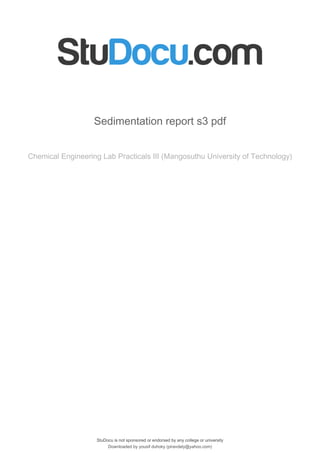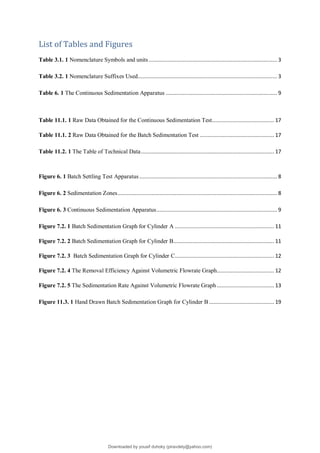This report discusses experiments on batch and continuous sedimentation. For batch
sedimentation, three cylinders containing calcium carbonate suspensions were allowed to settle
and the heights measured over time to determine settling velocities. Continuous sedimentation
involved increasing the flowrate through a sedimentation tank to determine removal efficiency
and sedimentation rate. Larger particles in Cylinder A settled fastest in batch tests. Removal
efficiency decreased with increasing flowrate in continuous tests, showing sedimentation
requires lower velocities. The size, shape and properties of particles impact sedimentation
rates.




















![SEDIMENTATION, May 2019
16 | P a g e
10. References
1. Sedimentation, Available from :
<https://www.mrwa.com/WaterWorksMnl/Chapter%2013%20Sedmentation.pdf>.
[29 August 2017].
2. Momentum and Impulse, Available from: <https://www.pearson.com/content/dam/one-
dot-com/one-dot-com/us/en/higher-ed/en/products-services/course-products/knight-
physics-4e-info/pdf/chapter11.pdf>. [29 August 2017].
3. Chapter 3 Separation Processes, Available from:
<http://www.polyu.edu.hk/edc/tdg/userfiles/file/490Q_ABCT/ICBPT_cht3Sep.pdf>[30
August 2017].
4. Lotta S., Marja N. 2015, Design and selection of separation processes, Available from:<
http://www.vtt.fi/inf/julkaisut/muut/2015/VTT-R-06143-15.pdf>. [30 August 2017].
5. Backhurst J. R., Harker J.H. & Richardson J. F 2002, Particle Technology and Separation
Processes, Butterworth-Heinemann, Oxford ,Amsterdam, Boston , London, New York,
Paris.
Downloaded by yousif duhoky (piravdely@yahoo.com)
lOMoARcPSD|4334469](https://image.slidesharecdn.com/sedimentation-report-s3-pdf-221011161825-31ea31a0/85/sedimentation-report-s3-pdf-pdf-21-320.jpg)


